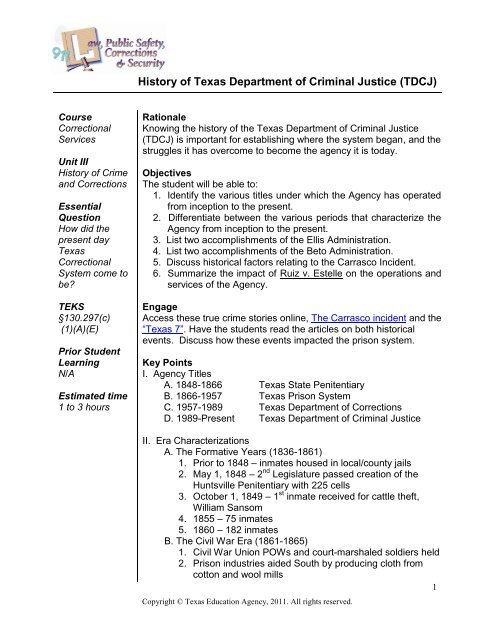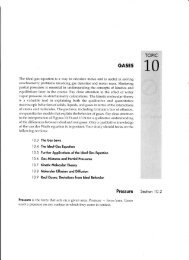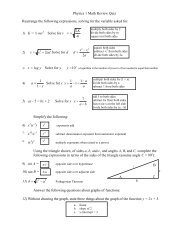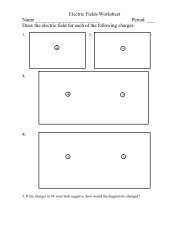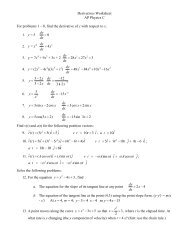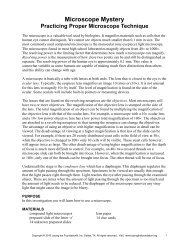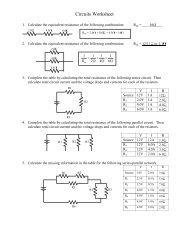History of Texas Department of Criminal Justice (TDCJ) - Birdville ...
History of Texas Department of Criminal Justice (TDCJ) - Birdville ...
History of Texas Department of Criminal Justice (TDCJ) - Birdville ...
You also want an ePaper? Increase the reach of your titles
YUMPU automatically turns print PDFs into web optimized ePapers that Google loves.
<strong>History</strong> <strong>of</strong> <strong>Texas</strong> <strong>Department</strong> <strong>of</strong> <strong>Criminal</strong> <strong>Justice</strong> (<strong>TDCJ</strong>)CourseCorrectionalServicesUnit III<strong>History</strong> <strong>of</strong> Crimeand CorrectionsEssentialQuestionHow did thepresent day<strong>Texas</strong>CorrectionalSystem come tobe?TEKS§130.297(c)(1)(A)(E)Prior StudentLearningN/AEstimated time1 to 3 hoursRationaleKnowing the history <strong>of</strong> the <strong>Texas</strong> <strong>Department</strong> <strong>of</strong> <strong>Criminal</strong> <strong>Justice</strong>(<strong>TDCJ</strong>) is important for establishing where the system began, and thestruggles it has overcome to become the agency it is today.ObjectivesThe student will be able to:1. Identify the various titles under which the Agency has operatedfrom inception to the present.2. Differentiate between the various periods that characterize theAgency from inception to the present.3. List two accomplishments <strong>of</strong> the Ellis Administration.4. List two accomplishments <strong>of</strong> the Beto Administration.5. Discuss historical factors relating to the Carrasco Incident.6. Summarize the impact <strong>of</strong> Ruiz v. Estelle on the operations andservices <strong>of</strong> the Agency.EngageAccess these true crime stories online, The Carrasco incident and the“<strong>Texas</strong> 7”. Have the students read the articles on both historicalevents. Discuss how these events impacted the prison system.Key PointsI. Agency TitlesA. 1848-1866 <strong>Texas</strong> State PenitentiaryB. 1866-1957 <strong>Texas</strong> Prison SystemC. 1957-1989 <strong>Texas</strong> <strong>Department</strong> <strong>of</strong> CorrectionsD. 1989-Present <strong>Texas</strong> <strong>Department</strong> <strong>of</strong> <strong>Criminal</strong> <strong>Justice</strong>II. Era CharacterizationsA. The Formative Years (1836-1861)1. Prior to 1848 – inmates housed in local/county jails2. May 1, 1848 – 2 nd Legislature passed creation <strong>of</strong> theHuntsville Penitentiary with 225 cells3. October 1, 1849 – 1 st inmate received for cattle theft,William Sansom4. 1855 – 75 inmates5. 1860 – 182 inmatesB. The Civil War Era (1861-1865)1. Civil War Union POWs and court-marshaled soldiers held2. Prison industries aided South by producing cloth fromcotton and wool mills1Copyright © <strong>Texas</strong> Education Agency, 2011. All rights reserved.
3. 1865 – only one prison still standing in the Confederatestates (Huntsville Penitentiary)C. The Convict Lease Era (1866-1909)1. Increased number <strong>of</strong> inmates2. 2 nd legislaturea) Leased inmate labor and use <strong>of</strong> facilitiesb) Outside camps establishedc) Inmates hired by railroad and plantation owners3. 1877-1882 – second prison built in Rusk4. Opened January, 1883D. The Farm System (1910-1936)1. 1910-1912a) Legislative changes to inmate accountsb) Industries slowed, farming expandedc) Less education and other reform effortsd) Leases were cancelled2. Large agricultural ranching operations became hallmarks<strong>of</strong> the prison system.3. Chain Gang: inmates leased to a private owner, and“chained” together during work to prevent their escape.4. Building Tenders: inmates used to “control” other inmatesand open/close cells.E. The Decline (1937-1947)1. Troubled times for prisons2. Turned purchased plantations into farms3. Corrupt and mismanaged administration4. Fraud, and poor treatment <strong>of</strong> inmates5. “Backsliding”a) Large influx <strong>of</strong> inmatesb) Brutalityc) Self-mutilationd) Sexual Perversione) Incompetencef) Petty Theft6. Darrington Farma) 333 inmates housed in a tank designed for 250b) Shower every three weeksc) NO laundry services7. Retrieve Farma) 475 inmates housed in a unit designed for 350b) 31 sleep on brick floorF. The Reform Era (1947-1973)1. Emphasis on reform, teaching, and recreation2. New Classification system3. 1931 – Prison rodeo established4. 1947 – Penal reformsCopyright © <strong>Texas</strong> Education Agency, 2011. All rights reserved.2
a) Modernized agricultural productionb) Initiated industrial productsc) Improvements in facilities5. 1948 – “Construction Division”a) Used inmate laborb) Prison-made bricksc) Prison-made concrete for new buildingsIII. Ellis AdministrationA. “Ellis Plan” implemented by O.B. EllisB. <strong>Texas</strong> Prison System renamed to <strong>Texas</strong> <strong>Department</strong> <strong>of</strong>CorrectionsC. Reform-minded1. Vocational/educational programs2. Housing/salary for staffD. Self-sufficient, Improved agricultural operationsII. Beto AdministrationA. Dr. George Beto, director <strong>of</strong> <strong>TDCJ</strong>B. Implemented the Windham School DistrictC. National recognition for clean, orderly, and secure institutionsD. 1964 – Cooper v. PateE. 1971 – Guajardo v. EstelleF. 1972 – Lamar v. C<strong>of</strong>fieldIII. Supreme Court DecisionsA. Cooper v. Pate – Prisoners have the right to challengeadministrative practices.B. Guajardo v. Estelle – <strong>TDCJ</strong> could not deny inmates the rightto correspond with inmates on the same or different unitsregarding legal matters.C. Lamar v. C<strong>of</strong>field – <strong>TDCJ</strong> prohibited from segregating<strong>of</strong>fender housing or jobs based on race.IV. Windham School DistrictA. Largest School District in <strong>Texas</strong>B. Established in 1969C. Offered GED and High School Diplomas to inmatesD. Junior- and Senior-level college coursesE. Rehabilitation programsF. Vocational trainingG. Furlough and community serviceH. Helped secure work and transition after releaseV. Prison-Made Goods ActA. 1963 – Produced materials for internal use and sale to otherCopyright © <strong>Texas</strong> Education Agency, 2011. All rights reserved.3
state agenciesB. “Occupational training” for inmatesC. Education, recreation, religion, physiological, andpsychological health care addedVI. Conflict and Consolidation (1973-1998) – Estelle administration:A. Ruiz v. EstelleB. The Carrasco Incident1. Weapons smuggled into the unit2. Hostages were killed3. Lasted eleven daysC. The Pack/Moore Homicides1. An <strong>of</strong>fender was acquitted for the homicides <strong>of</strong> thewarden and top prison <strong>of</strong>ficial.2. This caused much outrage amongst the prison staff andconcerns for safetyD. Death <strong>of</strong> Minnie Houston1. One <strong>of</strong> the first female correctional <strong>of</strong>ficers was murderedby an <strong>of</strong>fender in the <strong>of</strong>ficer’s dining hall.2. This raised additional concerns for the suitability <strong>of</strong>female correctional <strong>of</strong>ficers in male facilities (female<strong>of</strong>ficers were allowed in male facilities as a result <strong>of</strong> K.K.Coble v. <strong>TDCJ</strong>)E. <strong>TDCJ</strong> established in 19891. 1978 class action lawsuit challenged the conditions <strong>of</strong>confinement2. Longest running lawsuit3. Federal courts maintained control <strong>of</strong> <strong>TDCJ</strong> until 20024. Violations allegeda) Due processb) Cruel and unusual punishmentc) Crowding, and poor living/health and workconditionsVII. <strong>Texas</strong> <strong>Department</strong> <strong>of</strong> <strong>Criminal</strong> <strong>Justice</strong> (1972-Present)A. 1986 – Prison rodeo stopped due to cost <strong>of</strong> repair andoperationB. 1989 – <strong>TDCJ</strong> & Board <strong>of</strong> <strong>Criminal</strong> <strong>Justice</strong> were createdC. <strong>Texas</strong> <strong>Department</strong> <strong>of</strong> <strong>Criminal</strong> <strong>Justice</strong>, Institutional Division1. <strong>Department</strong> <strong>of</strong> Corrections2. Board <strong>of</strong> Pardons and Parole3. <strong>Texas</strong> Adult Probation CommissionVIII. Recent <strong>History</strong> (1998-Present)A. June 17, 2002 – Federal oversight under Ruiz was dismissedB. Connally Seven – “<strong>Texas</strong> 7”Copyright © <strong>Texas</strong> Education Agency, 2011. All rights reserved.4
1. Amended count procedures2. Revised security procedures3. Modified the <strong>of</strong>fender classification plan to includereassignment <strong>of</strong> <strong>of</strong>fenders to more appropriate securitylevelsC. Homicides <strong>of</strong> Daniel Nagle, Stanley Wiley, and RhondaOsborne5. Murdered by inmates6. Officer safety reviewed7. Initiatives to include body alarms, carry-on-personchemical agents, defensive tactics training, thrust vests(stab resistant vests), and BOSS chairs (x-ray chairs thatcheck body orifices for weaponsD. Hurricane Rita – 9,400 inmates were moved via airplane andvehicles prior to the hurricane hitting landE. CID reorganized to create better communication,coordination, consistency, and improve access to resources;revised into 6 regions.F. American Correctional Association (ACA) accreditationIX. Prison PopulationA. 1990s – the number <strong>of</strong> prison beds tripledB. Community supervision implementedC. State Jails createdD. Transfer facilities establishedE. 1998 – 124,000 in <strong>TDCJ</strong>, and 6,168 in private facilitiesF. Current Statistics8. 5 SAFPFs (Substance Abuse Felony PunishmentFacilities)9. 21 State Jail Facilities10. 82 PrisonsX. Types <strong>of</strong> <strong>Texas</strong> InstitutionsA. Substance Abuse Felony Punishment Facility (SAFPF)1. Therapeutic Community is a term applied to aparticipative, group-based approach to long-term mentaldisorders, personality disorders, and drug addiction. Theapproach is usually residential, with the clients andtherapists living together.2. Group and Individual Drug/Alcohol Counseling3. Beds are primarily reserved for probationers4. Intermediate Sanctions Facility5. 612-bed facilities6. Minimum sentence is 18 months: 6 months in unit, and atleast 12 months in residential treatment.7. 5 SAFPFs in <strong>Texas</strong>Copyright © <strong>Texas</strong> Education Agency, 2011. All rights reserved.5
B. State Jail Facility (SJF)1. 21 SFJ Units in <strong>Texas</strong>2. Low-level property/drug <strong>of</strong>fenders3. Serve as transfer facilities4. No good time/parole5. 180 days to 2 yearsC. Prisons1. 82 Prison Units in <strong>Texas</strong>2. High level drug/property <strong>of</strong>fenders, violent <strong>of</strong>fenders3. Educational/vocational programs4. Prison industries5. Receive good time/parole6. $42.54 per day to incarcerate an <strong>of</strong>fenderD. Other Facilities1. Mentally Retarded Offender Program (MROP)2. Transfer Facility – Temporarily houses inmates that arebeing permanently assigned3. Pre-Release – Educational/Vocational training, life skillstransitions during last 12 months4. Psychiatry – Mentally ill that require extensive medicationand therapy5. Medical – Disease or medical condition requiringextensive medical careXI. ExecutionsA. Early <strong>History</strong>1. Prior to 1923 – <strong>Texas</strong> counties were responsible for theirown executions.2. 1819-1923 – hanging was the means <strong>of</strong> execution3. 1923 – executions by electric chair ordered to occur inHuntsville, TXB. Electric Chair1. The State <strong>of</strong> <strong>Texas</strong> executed the first <strong>of</strong>fender byelectrocution on 2/8/1924 (Charles Reynolds).2. On that same date, four additional <strong>of</strong>fenders, EwellMorris, George Washington, Mack Matthews, and MelvinJohnson, were executed.3. The State <strong>of</strong> <strong>Texas</strong> executed the last <strong>of</strong>fender byelectrocution on 7/30/1964 (Joseph Johnson).C. Cruel and Unusual Punishment1. June 29, 1972 – U.S. Supreme Court ruled the electricchair violated the 8 th amendment2. 52 inmates on death row sentences commuted to life3. March 1973 – Death row was empty4. <strong>Texas</strong> Penal Code revised – executions resumed on1/1/1974Copyright © <strong>Texas</strong> Education Agency, 2011. All rights reserved.6
5. Under new law (#507) John Devries was placed on deathrow on 2/15/1974. Devries committed suicide (7/1/1974)by hanging himself with bed sheets.D. Lethal Injection1. Adopted 19772. The State <strong>of</strong> <strong>Texas</strong> executed the first <strong>of</strong>fender by lethalinjection on 12/7/1982. Charlie Brooks, <strong>of</strong> Tarrant County,was executed for the kidnap/murder <strong>of</strong> a Fort Worth automechanic.3. Lethal Injection consists <strong>of</strong>:a) Sodium Thiopental (lethal dose – sedates person)b) Pancuronium Bromide (muscle relaxant –collapsesdiaphragm and lungs)c) Potassium Chloride (stops heart beat)4. The <strong>of</strong>fender is usually pronounced dead approximately 7minutes after the lethal injection begins.5. Cost per execution for the drugs used : $86.08E. <strong>Texas</strong> Capital Crimes1. Murder <strong>of</strong> a public safety <strong>of</strong>ficer or firefighter2. Murder during the commission <strong>of</strong> kidnapping, burglary,robbery, aggravated sexual assault, arson, or obstructionor retaliation3. Murder for remuneration4. Murder during a prison escape5. Murder <strong>of</strong> a correctional employee6. Murder by a state prison inmate who is serving a lifesentence for any <strong>of</strong> five <strong>of</strong>fenses (murder, capital murder,aggravated kidnapping, aggravated sexual assault, oraggravated robbery)7. Multiple murders8. Murder <strong>of</strong> an individual under six years <strong>of</strong> ageF. Death Row1. Average Time on Death Row prior to Execution: 10.26years2. Shortest Time on Death Row prior to Execution: 248 days3. Longest Time on Death Row prior to Execution: 8,854days (24 years)4. Average Age <strong>of</strong> Executed Offenders: 395. Youngest at Time <strong>of</strong> Execution: 246. Oldest at Time <strong>of</strong> Execution: 66ActivitiesWho Wants to be a Millionaire Game (Power Point)Assessments<strong>History</strong> <strong>of</strong> <strong>TDCJ</strong> ExamCopyright © <strong>Texas</strong> Education Agency, 2011. All rights reserved.7
Discussion RubricMaterials<strong>History</strong> <strong>of</strong> <strong>TDCJ</strong> PowerPoint<strong>Texas</strong> Institutions PowerPointWho Wants to be a Millionaire Game (PowerPoint)Internet accessResources<strong>Texas</strong> <strong>Department</strong> <strong>of</strong> <strong>Criminal</strong> <strong>Justice</strong>http://www.tdcj.state.tx.us/The <strong>Texas</strong> 7http://www.trutv.com/library/crime/gangsters_outlaws/cops_others/seven/20.html?print=yesCarracso Incidenthttp://web3.unt.edu/untpress/catalog/detail.cfm?ID=181Accommodations for Learning DifferencesFor reinforcement, students list the different eras <strong>of</strong> the <strong>Texas</strong> PrisonSystem, and summarize the major developments that came fromthem.For enrichment, students research the Windham School District t<strong>of</strong>ind out what kind <strong>of</strong> degrees inmates can earn while in prison.National and State Education Standards<strong>Texas</strong> Essential Knowledge and Skills§130.297. Correctional Services (One to Two Credits)(1) The student researches the history <strong>of</strong> correctional services. Thestudent is expected to:(A) examine the history <strong>of</strong> corrections in the United States and<strong>Texas</strong>;(E) identify ongoing academic education to develop a positivepublic image.College and Career Readiness StandardsIV. ListeningB. Listen effectively in informal and formal situations3. Listen actively and effectively in group discussions.Copyright © <strong>Texas</strong> Education Agency, 2011. All rights reserved.8
Name:_________________________Date:___________________________<strong>History</strong> <strong>of</strong> <strong>Texas</strong> <strong>Department</strong> <strong>of</strong> <strong>Criminal</strong> <strong>Justice</strong> ExamMatch the Agency name with the correct time period.1. ______ <strong>Texas</strong> <strong>Department</strong> <strong>of</strong> Corrections a. 1957-19892. ______ <strong>Texas</strong> Prison System b. 1989-present3. ______ <strong>Texas</strong> State Penitentiary c. 1848-18664. ______ <strong>Texas</strong> <strong>Department</strong> <strong>of</strong> <strong>Criminal</strong> <strong>Justice</strong> d. 1866-1957Multiple Choice5. ______ Which <strong>of</strong> the following eras was characterized by the creation <strong>of</strong> the <strong>Texas</strong>State Penitentiary?a. Civil War Erab. The Reform yearsc. The Formative Yearsd. Conflict and Consolidation6. ______ <strong>Texas</strong>' first inmate was given a prison sentence for ______________?a. Murderb. Cattle theftc. Assaultd. Public intoxication7. ______ The Decline included which two units that were overcrowded with inmates?a. Retrieve/Darringtonb. Connally/Ruizc. Beto/Ellisd. Estelle/Huntsville8. ______ The civil war ended with 3 units still standing in the confederate states.a. Trueb. False9. ______ War-time prisoners were made to manufacture clothing in the cotton andwool mills.a. Trueb. False10. ______ Chain Gangs originated in the Convict Lease Era.a. Trueb. False11. ______ The Farm System years included expansion <strong>of</strong> agricultural productions.a. Trueb. FalseCopyright © <strong>Texas</strong> Education Agency, 2011. All rights reserved.9
12. ______ Which lawsuit was not part <strong>of</strong> the Beto administration?a. Cooper v. Pateb. Lamar v. C<strong>of</strong>fieldc. Guajardo v. Estelled. Ruiz v. Estelle13. ______ The Ellis administration was characterized by corruption.a. Trueb. False14. ______ The Windham School District allows inmates to obtain their GED or HighSchool Diploma.a. Trueb. False15. ______ Inmates are not allowed to produce materials for internal use and sale toother state agencies.a. Trueb. False16. ______ Which <strong>of</strong> the following was a reason for the Carrasco Incident?a. poor living conditionsb. violation <strong>of</strong> due process rightsc. weapons were smuggled into the unitd. overcrowding17. ______ Which Era was plagued with events that changed the <strong>Texas</strong> Prison systemdramatically?a. Conflict and Consolidationb. The Civil War Erac. The Reform yearsd. Present era18. ______ Which <strong>of</strong> the following was not part <strong>of</strong> the Ruiz v. Estelle case?a. Overcrowdingb. Foodc. Due Processd. Cruel and Unusual punishment19. ______ In which lawsuit did the U.S. Supreme Court say that <strong>of</strong>fenders have theright to challenge administrative practices?a. Ruiz v. Estelleb. Cooper v. Patec. Lamar v. C<strong>of</strong>fieldd. Guajardo v. Estelle20. ______ The Prison-Made Goods Act states that inmates can only sell products toprivate persons.a. Trueb. FalseCopyright © <strong>Texas</strong> Education Agency, 2011. All rights reserved.10
<strong>History</strong> <strong>of</strong> <strong>Texas</strong> <strong>Department</strong> <strong>of</strong> <strong>Criminal</strong> <strong>Justice</strong> Exam Key1. A2. D3. C4. B5. C6. B7. A8. B9. A10. B11. A12. D13. B14. A15. B16. C17. C18. B19. B20. BCopyright © <strong>Texas</strong> Education Agency, 2011. All rights reserved.11
Name_______________________________________Date_______________________________Discussion RubricObjectives4 pts.Excellent3 pts.Good2 pts. Needs SomeImprovement1 pt. Needs MuchImprovementN/APts.Participates in group discussionEncourages others to join theconversationKeeps the discussion progressing toachieve goalsShares thoughts actively while <strong>of</strong>feringhelpful recommendations to othersGives credit to others for their ideasRespects the opinions <strong>of</strong> othersInvolves others by asking questions orrequesting inputExpresses thoughts and ideas clearlyand effectivelyTotal Points (32 pts.)Comments:Copyright © <strong>Texas</strong> Education Agency, 2011. All rights reserved.12


